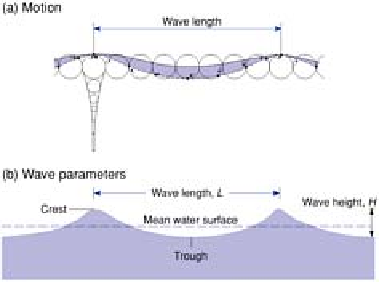Environmental Engineering Reference
In-Depth Information
fall of a beach ball as each wave passes but otherwise remains in the same general
position and spins. In a given wind field, a series of waves, or
wave train
, are separated
by their
wavelength
(
L
) and
wave period
(
T
) (Plate 11.3). Wave velocity
V
=
L
/
T
. Wave
height (
H
) is determined by wind speed, duration and
fetch
, or distance travelled over
water. It is also the diameter of the orbital path of individual water particles as they rotate
and an important determinant of wave energy,
E
.
E
= 1/8 ρ
H
2
(where ρ is water density).
L
/2, denoting
wave base
, is the depth beyond which the declining oscillatory motion has
effectively ceased and is no longer able to disturb the sea bed. As a wave enters water
depths less than
L
/2 a circular orbit of particles cannot be maintained. Bed friction slows
the forward part of the loop first, forcing the still advancing rear to climb, steepening and
elevating the wave, and eventually causing it to break. In this way each wave also catches
up on decelerating waves ahead, compressing the wave train and so shortening
wavelength. This is demonstrated dramatically by
seismic sea waves
or tsunamis,
triggered by earthquakes. They can travel at over 500 km h
−1
but at almost imperceptible
heights of less than 0·5 m - until they decelerate on approaching land, where wave
heights build progressively and catastrophically to 30 m or more. Geomorphic impacts of
wave-related processes are examined in Chapter 17.
Figure 11.13
Wave (a) motion and (b) form in open water.

